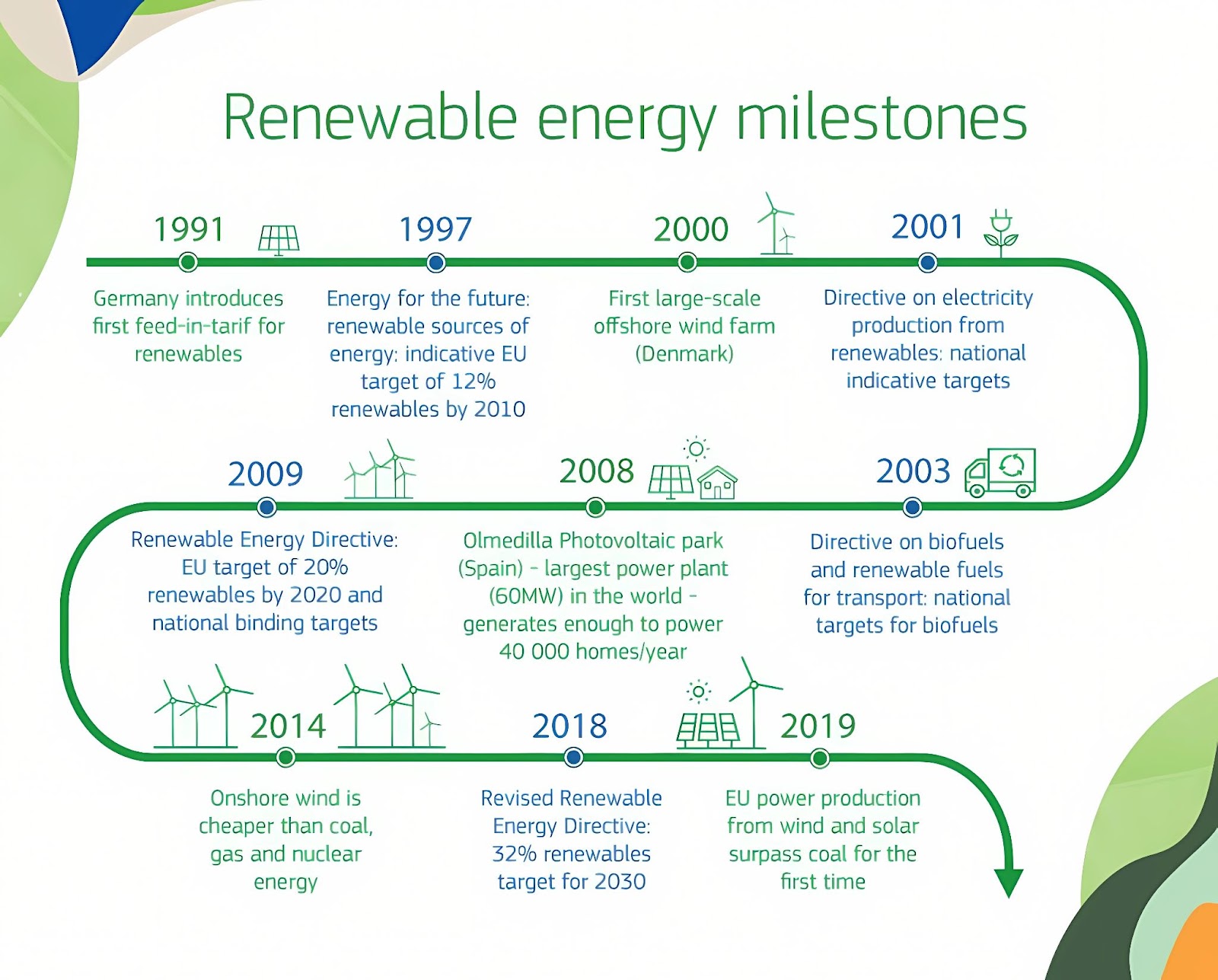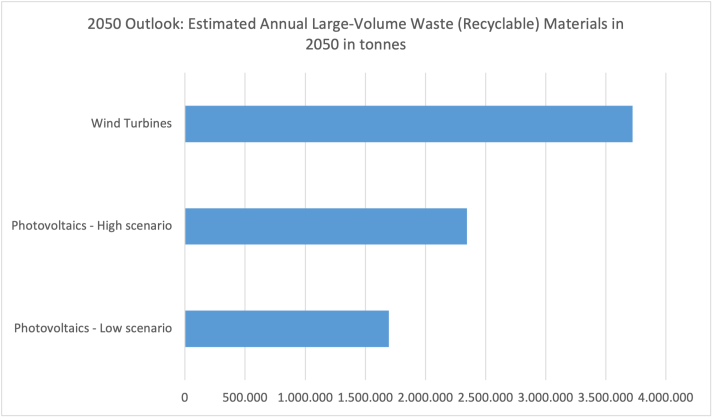Wind power is growing at an unstoppable pace in the EU, and with it, its waste. In this article, we focus on wind energy waste, examining its environmental impact and the progress being made in its responsible management.
.png)
The EU’s most decisive commitment to renewables began in 2008 with the launch of the so-called “20-20-20 Package,” in which it pledged to cut greenhouse gas emissions by 20%, ensure that renewables would account for 20% of primary energy use, and reduce energy consumption by 20%, all by 2020. It was a pivotal moment, with then-EU President Nicolas Sarkozy stating: “No other continent in the world has adopted such strict rules to fight climate change.”
Much has changed since then, but the commitment to renewables remains strategic. This course, driven by the climate crisis, was accelerated by Russia’s invasion of Ukraine in 2022, which exposed Europe’s dependence on Russian gas. The resulting energy crisis led to a significant increase in energy prices and a reassessment of energy policies. This situation prompted record investment in renewables, with the EU allocating nearly €110 billion in 2023 to clean energy generation.
Another key factor is the dependence on third countries for the supply of critical minerals, essential in renewable technologies such as batteries, wind turbines, solar panels, and electric vehicles. The EU, fully dependent on imports, has responded with the Critical Raw Materials Act (CRMA), which, among other measures, seeks to ensure that at least 25% of its annual consumption comes from recycling. Innovation in recycling and material recovery is being promoted, which could also boost the future reuse of renewable components.
Indeed, while the energy transition to renewables is essential, we cannot ignore the side effects: the environmental impact of extracting materials to manufacture these technologies and the generation of large volumes of waste at the end of their life cycle.

In 2023, renewables accounted for 24.5% of energy use in the EU, an increase of 1.4% compared to the previous year. Regarding total electricity generated:
Hydropower and wind together account for more than two-thirds of total electricity generated from renewables, and wind has become the most important renewable energy source in the EU today.
Moreover, in 2014, onshore wind energy became cheaper than coal, gas, and nuclear energy. By 2019, the EU’s wind and solar power production surpassed that of coal for the first time, making both sources as competitive, or even cheaper, than fossil fuels in most countries. More records: in offshore wind, Europe achieved an all-time high in 2023, connecting 3.8 GW of offshore capacity in a single year.
A wind turbine consists primarily of concrete, iron, steel, polymers, and fibreglass-reinforced composites.
Due to the concrete, iron, and steel components, a wind turbine is often considered to be 85% recyclable, though this figure excludes the foundation.
In the European Union, iron, steel, and aluminium are collected and recycled quite frequently. Concrete is also collected but is rarely recycled as such; instead, it is typically crushed and reused as aggregate.
Wind turbines contain valuable minerals such as neodymium, used in permanent magnets and considered a critical raw material (CRM). Technically, there are methods to recover these magnets during processing, and since these are high-value materials, recycling is economically viable. Nevertheless, in practice, very little neodymium is currently recycled in the EU.
The remaining turbine materials are polymers and fibreglass-reinforced composites, mostly found in the blades. These materials remain difficult to recycle, and it is considered unlikely that recovered materials from the blades can substitute primary materials used to manufacture new ones.
Overall, metallic materials in the blades represent just about 1% of their total weight but are not easy to dismantle. Even though blades are made in several parts, they are usually bonded with adhesives that cannot be easily separated.
And there lies the dilemma: although most of a wind turbine can be recycled, the blades, as of today, are not being recycled effectively.
By 2030, the EU could have 42,500 wind turbines, and 86,000 by 2050. It is expected that wind infrastructure will generate more waste than solar by 2050, with an estimated 10 million tonnes of wind turbine waste per year by then.
Despite this, it is estimated that between 50% and 60% of turbines could be reused. Some smaller blades are kept as spare parts or relocated for reinstallation elsewhere.
By 2050, photovoltaic panels and wind turbines together are expected to generate annual waste including 2.9 million tonnes of steel, 191,527 tonnes of aluminium, and 52,874 tonnes of copper.
In fact, WindEurope points out that many of Europe’s onshore wind farms are nearing the end of their planned service life. Currently, 22 GW of wind capacity in Europe has been operating for over 20 years. By 2030, that figure will rise to 52 GW with more than two decades in operation.

As for environmental impact, this study compares seven methods for managing wind turbine blades at the end of their life, divided into two groups: circular options (1–5) and linear ones (6–7):
1. Reuse: using the blades or their parts for purposes other than the original.
2. Grinding: breaking down materials into powder or fibres; resin-rich powder (for construction materials) and fibres (for new composites) are recovered.
3. Solvolysis: chemical recycling that dissolves polymers and recovers fibres.
4. Pyrolysis: thermal decomposition generating oil, gases, and inert fibres.
5. Co-processing in cement plants: reusing waste to reduce fuel and mineral use.
6. Incineration: burning waste to generate ash and energy.
7. Landfilling: disposal of waste in inert waste deposits.
The study concludes that the options recovering higher-quality materials, such as solvolysis, also offer the greatest potential to reduce waste and climate impact.
As we have seen, while some components can be reused or recycled, others, such as the large, heavy, and structurally complex composite blades, represent a genuine technical and industrial challenge. Due to these difficulties, it is common for blades to end up in landfills or incinerators, leading to a loss of valuable resources and a negative environmental impact.
For obvious reasons, landfilling is not a desirable solution for end-of-life turbine blades, and some countries have directly banned such composite waste from landfills and disposal costs vary widely: in Denmark, it can reach €120/tonne; in Ireland, around €113; in the US, approximately €55; in the UK, up to €130; and in Germany, as much as €300/tonne.
The exponential growth of renewables in Europe brings with it a new and urgent challenge: the sustainable management of their waste. With millions of tonnes of materials expected at the end of wind turbines' life cycles in the coming decades, it is vital to accelerate the development of recycling and reuse solutions, especially for complex components like blades. Investing in innovation, banning landfill disposal, and promoting clear and ambitious regulations will help transform this challenge into an opportunity to move towards a truly circular economy in the energy sector.